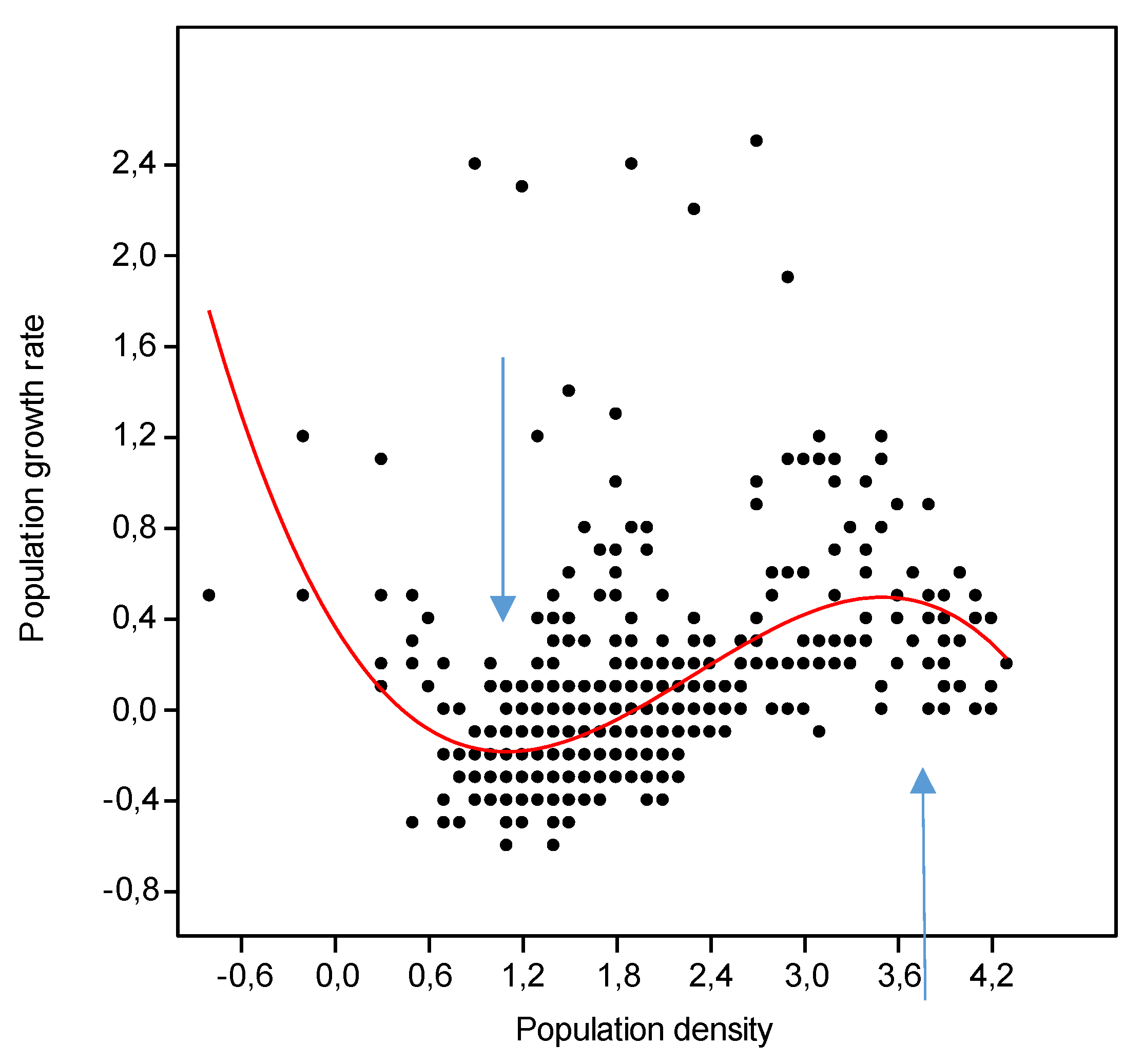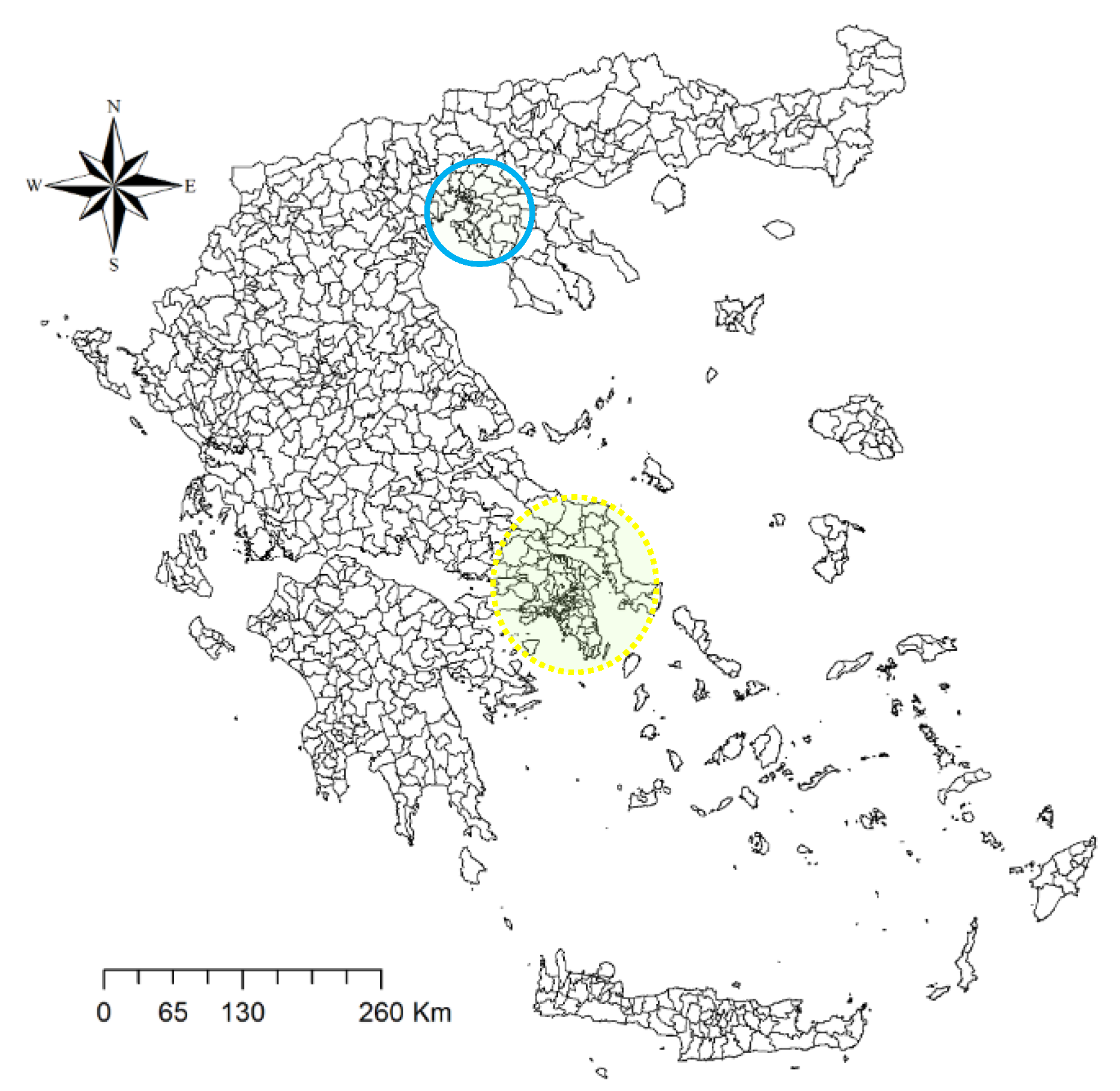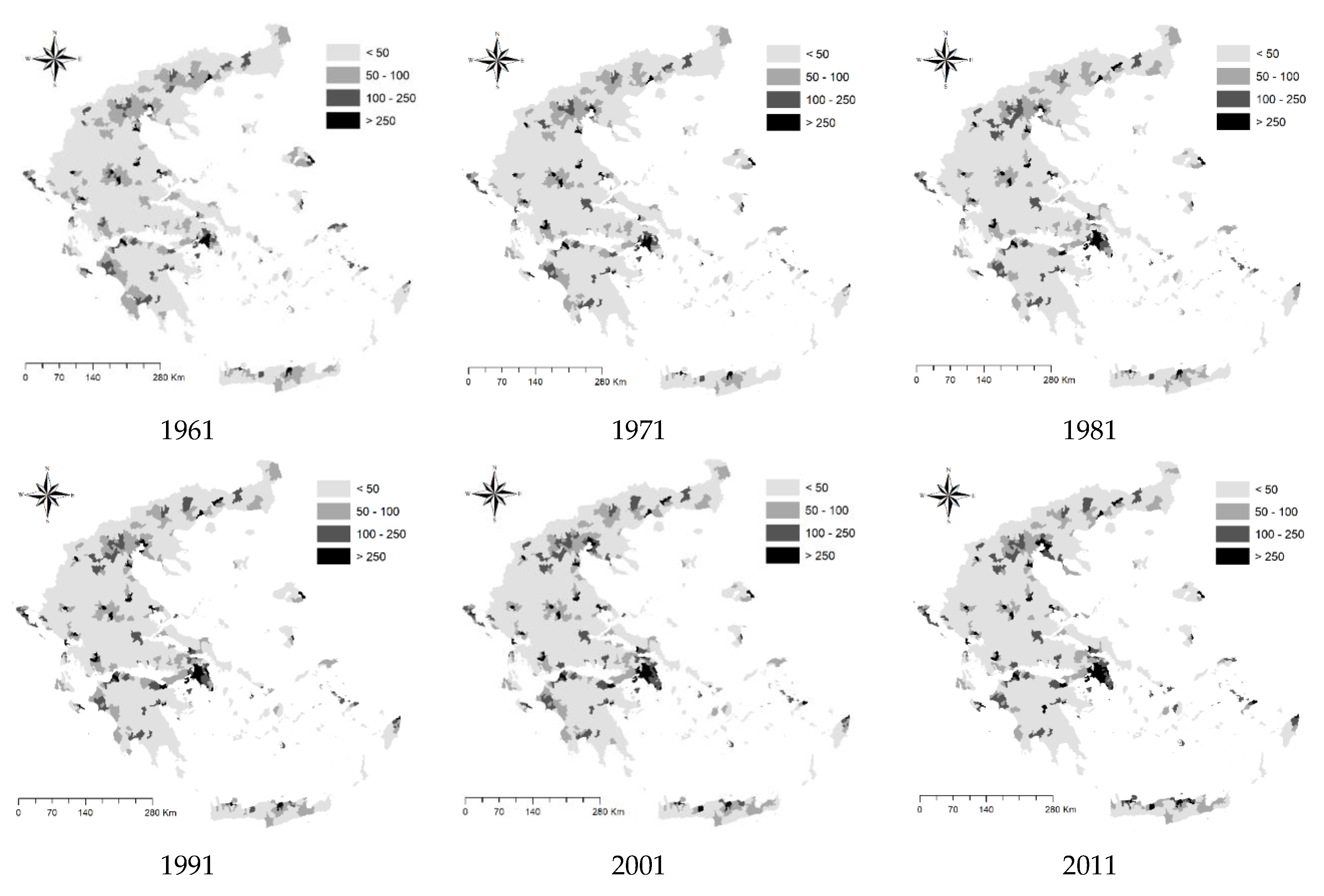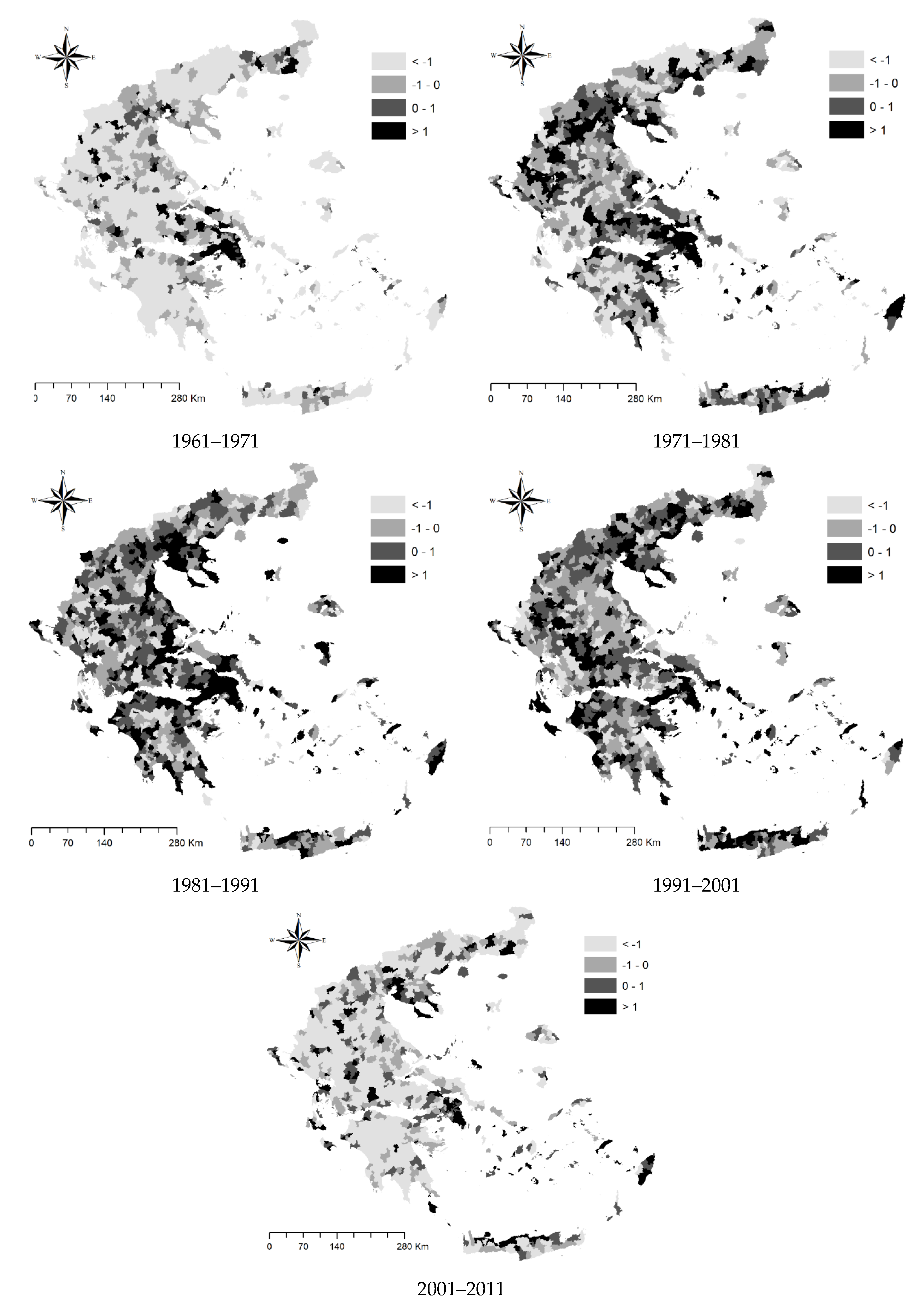Population Dynamics and Agglomeration Factors: A Non-Linear Threshold Estimation of Density Effects
Abstract
1. Introduction
Density-dependent Population Growth and the Spatial Distribution of Settlements
2. Methodology
2.1. Study Area
2.2. Data and Indicators
2.3. Statistical Analysis
- —
- a linear form hypothesizing a unique effect—positive or negative—of population concentration on demographic dynamics (growth or decline) along the entire density gradient based on the following equation:Y = a0 + a1X + e
- —
- a quadratic form assuming a divergent effect of population density on growth rates below (or above) a defined threshold:Y = a0 + a1X+ a2X2 + e
- —
- a cubic form assuming two divergent effects of population density on growth rates below (or above) two thresholds:Y = a0 + a1X+ a2X2 + a3X3 + e
- —
- more complex polynomial forms (forth- and fifth-grade) assuming multiple, divergent effects of population density on growth rates below (or above) defined thresholds:Y = a0 + a1X+ a2X2 + a3X3 + a4X4 + eY = a0 + a1X+ a2X2 + a3X3 + a4X4 + a5X5 + e.
3. Results
4. Discussion
5. Conclusions
Author Contributions
Funding
Conflicts of Interest
References
- Combes, P.P.; Duranton, G.; Gobillon, L. The identification of agglomeration economies. J. Econ. Geogr. 2011, 11, 253–266. [Google Scholar] [CrossRef]
- Gardiner, B.; Martin, R.; Tyler, P. Does spatial agglomeration increase national growth? Some evidence from Europe. J. Econ. Geogr. 2011, 11, 979–1006. [Google Scholar] [CrossRef]
- Haase, A.; Bernt, M.; Großmann, K.; Mykhnenko, V.; Rink, D. Varieties of shrinkage in European cities. Eur. Urban Reg. Stud. 2016, 2, 86–102.10. [Google Scholar] [CrossRef]
- Tóth, G.; Nagy, Z. The world’s economic centre of gravity. Reg. Stat. 2017, 6, 177–180. [Google Scholar]
- Petrakos, G.C. Urban concentration and agglomeration economies: Re-examining the relationship. Urban Stud. 1992, 29, 1219–1229. [Google Scholar] [CrossRef]
- Turok, I. Cities, regions and competitiveness. Reg. Stud. 2004, 38, 1061–1075. [Google Scholar] [CrossRef]
- Combes, P.P.; Duranton, G.; Overman, H.G. Agglomeration and the adjustment of the spatial economy. Pap. Reg. Sci. 2005, 84, 311–349. [Google Scholar] [CrossRef]
- Munafò, M.; Salvati, L.; Zitti, M. Estimating soil sealing at country scale – Italy as a case study. Ecol. Indic. 2013, 26, 36–43. [Google Scholar] [CrossRef]
- Gavalas, V.S.; Rontos, K.; Salvati, L. Who becomes an unwed mother in Greece? Socio-demographic and geographical aspects of an emerging phenomenon. Popul. Spaceand Place 2014, 20, 250–263. [Google Scholar] [CrossRef]
- Morelli, V.G.; Rontos, K.; Salvati, L. Between suburbanisation and re-urbanisation: Revisiting the urban life cycle in a Mediterranean compact city. Urban Res. Pract. 2014, 7, 74–88. [Google Scholar] [CrossRef]
- Russo, A.P.; Serrano Giné, D.; Pérez Albert, M.Y.; Brandajs, F. Identifying and Classifying Small and Medium Sized Towns in Europe. Tijdschr. Voor Econ. En Soc. Geogr. 2017, 108, 380–402. [Google Scholar] [CrossRef]
- Melo, P.C.; Graham, D.J.; Noland, R.B. A meta-analysis of estimates of urban agglomeration economies. Reg. Sci. Urban Econ. 2009, 39, 332–342. [Google Scholar] [CrossRef]
- Solon, J. Spatial context of urbanization: Landscape pattern and changes between 1950 and 1990 in the Warsaw metropolitan area, Poland. Landsc. Urban Plan. 2009, 93, 250–261. [Google Scholar] [CrossRef]
- Serra, P.; Vera, A.; Tulla, A.F.; Salvati, L. Beyond urban–rural dichotomy: Exploring socioeconomic and land-use processes of change in Spain (1991–2011). Appl. Geogr. 2014, 55, 71–81. [Google Scholar] [CrossRef]
- Weilenmann, B.; Seidl, I.; Schulz, T. The socioeconomic determinants of urban sprawl between 1980 and 2010 in Switzerland. Landsc. Urban Plan. 2017, 157, 468–482. [Google Scholar] [CrossRef]
- Salvati, L. Agro-forest landscape and the ‘fringe’ city: A multivariate assessment of land-use changes in a sprawling region and implications for planning. Sci. Total Environ. 2014, 490, 715–723. [Google Scholar] [CrossRef]
- Lee, R.D. Population dynamics of humans and other animals. Demography 1987, 24, 443–465. [Google Scholar] [CrossRef]
- Fowler, C.W. Density dependence as related to life history strategy. Ecology 1981, 62, 602–610. [Google Scholar] [CrossRef]
- Turchin, P. Rarity of density dependence or population regulation with lags? Nature 1990, 344, 660–663. [Google Scholar] [CrossRef]
- Hopfenberg, R. Human Carrying Capacity Is Determined by Food Availability. Popul. Environ. 2003, 25, 109–117. [Google Scholar] [CrossRef]
- Berryman, A.A. Principles of Population Dynamics and Their Application; Stanley Thornes: Cheltenham, UK, 1999. [Google Scholar]
- Cohen, J.E. Human population: The next half century. Science 2003, 302, 1172–1175. [Google Scholar] [CrossRef] [PubMed]
- Lima, M.; Berryman, A.A. Positive and negative feedbacks in human population dynamics: Future equilibrium or collapse? Oikos 2011, 120, 1301–1310. [Google Scholar] [CrossRef]
- Galor, O.; Weil, D.N. From Malthusians stagnation to modern growth. Popul. Econ. Growth 1999, 89, 150–154. [Google Scholar] [CrossRef]
- Bosker, M. Growth, agglomeration and convergence: A space-time analysis for European regions. Spat. Econ. Anal. 2007, 2, 91–100. [Google Scholar] [CrossRef]
- Baldini, R. The importance of population growth and regulation in human life history evolution. PLoS ONE 2015, 10. [Google Scholar] [CrossRef] [PubMed]
- Lemelin, A.; Rubiera-Morollón, F.; Gómez-Loscos, A. Measuring urban agglomeration: A refoundation of the mean city-population size index. Soc. Indic. Res. 2016, 125, 589–612. [Google Scholar] [CrossRef]
- Beale, C.L. Rural Depopulation in the United States: Some Demographic Consequences of Agricultural Adjustments. Demography 1964, 1, 264–272. [Google Scholar] [CrossRef]
- Lutz, W.; Sanderson, W.; Scherbov, S. The end of world population growth. Nature 2001, 412, 543–545. [Google Scholar] [CrossRef]
- Strulik, H. Learning-by-doing, population pressure, and the theory of demographic transition. J. Popul. Econ. 1997, 10, 285–298. [Google Scholar] [CrossRef]
- Grafeneder-Weissteiner, T.; Prettner, K. Agglomeration and demographic change. J. Urban Econ. 2013, 74, 1–11. [Google Scholar] [CrossRef]
- Beenstock, M.; Felsenstein, D. Marshallian theory of regional agglomeration. Pap. Reg. Sci. 2010, 89, 155–172. [Google Scholar] [CrossRef]
- Kincses, Á.; Nagy, Z.; Tóth, G. Modelling the spatial structure of Europe. Reg. Stat. 2014, 4, 40–54. [Google Scholar] [CrossRef]
- Boserup, E. Population and Technological Change: A Study of Long-Term Trends; University of Chicago Press: Chicago, IL, USA, 1981. [Google Scholar]
- Price, D. Carrying Capacity Reconsidered. Population and Environment 1999, 21, 5–26. [Google Scholar] [CrossRef]
- André, M.F. Depopulation, land-use change and landscape transformation in the French Massif Central. Ambio 1998, 27, 351–353. [Google Scholar]
- Hoggart, K.; Paniagua, A. The restructuring of rural Spain? J. Rural Stud. 2001, 17, 63–80. [Google Scholar] [CrossRef]
- Alados, C.L.; Errea, P.; Gartzia, M.; Saiz, H.; Escós, J. Positive and negative feedbacks and free-scale pattern distribution in rural-population dynamics. Plos One 2014, 9, 1–12. [Google Scholar] [CrossRef][Green Version]
- Beeson, P.E.; DeJong, D.N.; Troesken, W. Population growth in US counties, 1840–1990. Reg. Sci. Urban Econ. 2001, 31, 669–699. [Google Scholar] [CrossRef][Green Version]
- Lutz, W.; Qiang, R. Determinants of human population growth. Phil. Trans. R. Soc. B. Biol. Sci. 2002, 357, 1197–1210. [Google Scholar] [CrossRef]
- Berliant, M.; Wang, P. Dynamic urban models: Agglomeration and growth. Contrib. Econ. Anal. 2004, 266, 531–581. [Google Scholar]
- Rodriguez-Pose, A.; Fratesi, U. Between development and social policies: The impact of European Structural Funds in Objective 1 regions. Reg. Stud. 2004, 38, 97–113. [Google Scholar] [CrossRef]
- Salvati, L.; Carlucci, M. The economic and environmental performances of rural districts in Italy: Are competitiveness and sustainability compatible targets? Ecol. Econ. 2011, 70, 2446–2453. [Google Scholar] [CrossRef]
- Zitti, M.; Ferrara, C.; Perini, L.; Carlucci, M.; Salvati, L. Long-Term Urban Growth and Land Use Efficiency in Southern Europe: Implications for Sustainable Land Management. Sustainability 2015, 7, 3359–3385. [Google Scholar] [CrossRef]
- Varga, L.; Tóth, G.; Néda, Z. An improved radiation model and its applicability for understanding commuting patterns in Hungary. Reg. Stat. 2016, 6, 27–38. [Google Scholar] [CrossRef]
- Zambon, I.; Serra, P.; Sauri, D.; Carlucci, M.; Salvati, L. Beyond the ‘Mediterranean city’: Socioeconomic disparities and urban sprawl in three Southern European cities. Geogr. Ann. Ser. Bhuman Geogr. 2017, 99, 319–337. [Google Scholar] [CrossRef]
- Oueslati, W.; Alvanides, S.; Garrod, G. Determinants of urban sprawl in European cities. Urban Stud. 2015, 52, 1594–1614. [Google Scholar] [CrossRef]
- Salvati, L.; Carlucci, M. Patterns of sprawl: The socioeconomic and territorial profile of dispersed urban areas in Italy. Reg. Stud. 2016, 50, 1346–1359. [Google Scholar] [CrossRef]
- Partridge, M.D.; Rickman, D.S.; Ali, K.; Olfert, M.R. Do new economic geography agglomeration shadows underlie current population dynamics across the urban hierarchy? Pap. Reg. Sci. 2009, 88, 445–466. [Google Scholar] [CrossRef]
- Portnov, B.A.; Schwartz, M. Urban clusters as growth foci. J. Reg. Sci. 2009, 49, 287–310. [Google Scholar] [CrossRef]
- Salvati, L.; Gemmiti, R.; Perini, L. Land degradation in Mediterranean urban areas: An unexplored link with planning? Area 2012, 44, 317–325. [Google Scholar] [CrossRef]
- Kabisch, N.; Haase, D. Diversifying European agglomerations: Evidence of urban population trends for the 21st century. Popul. Space Place 2011, 17, 236–253. [Google Scholar] [CrossRef]
- Pili, S.; Grigoriadis, E.; Carlucci, M.; Clemente, M.; Salvati, L. Towards Sustainable Growth? A Multi-criteria Assessment of (Changing) Urban Forms. Ecol. Indic. 2017, 76, 71–80. [Google Scholar] [CrossRef]
- Duvernoy, I.; Zambon, I.; Sateriano, A.; Salvati, L. Pictures from the Other Side of the Fringe: Urban Growth and Peri-urban Agriculture in a Post-industrial City (Toulouse, France). J. Rural Stud. 2018, 57, 25–35. [Google Scholar] [CrossRef]
- Tapia, F.J.B.; Díez-Minguela, A.; Martinez-Galarraga, J. Tracing the evolution of agglomeration economies: Spain, 1860–1991. J. Econ. Hist. 2018, 78, 81–117. [Google Scholar] [CrossRef]
- Crescenzi, R.; Luca, D.; Milio, S. The geography of the economic crisis in Europe: National macroeconomic conditions, regional structural factors and short-term economic performance. Camb. J. Reg. Econ. Soc. 2016, 9, 13–32. [Google Scholar] [CrossRef]
- Lauf, S.; Haase, D.; Kleinschmit, B. The effects of growth, shrinkage, population aging and preference shifts on urban development—A spatial scenario analysis of Berlin, Germany. Land Use Policy 2016, 52, 240–254. [Google Scholar] [CrossRef]
- Carlucci, M.; Grigoriadis, E.; Rontos, K.; Salvati, L. Revisiting an Hegemonic Concept: Long-term ‘Mediterranean Urbanization’ in between city re-polarization and metropolitan decline. Appl. Spat. Anal. Policy 2017, 10, 347–362. [Google Scholar] [CrossRef]
- Kiochos, P.; Rontos, K. Urbanization and Large Cities in the Mediterranean Countries. Arch. Econ. Hist. 1999, 10, 1–2. [Google Scholar]
- Mykhnenko, V.; Turok, I. East European cities—patterns of growth and decline, 1960–2005. International Planning Studies 2008, 13, 311–342. [Google Scholar] [CrossRef]
- Paulsen, K. Geography, policy or market? New evidence on the measurement and causes of sprawl (and infill) in US metropolitan regions. Urban Stud. 2014, 51, 2629–2645. [Google Scholar] [CrossRef]
- Rickman, D.S.; Wang, H. US regional population growth 2000–2010: Natural amenities or urban agglomeration? Pap. Reg. Sci. 2017, 96, S69–S90. [Google Scholar] [CrossRef]
- Petrakos, G.; Rodríguez-Pose, A.; Rovolis, A. Growth, integration, and regional disparities in the European Union. Environ. Plan. A 2005, 37, 1837–1855. [Google Scholar] [CrossRef]
- Di Feliciantonio, C.; Salvati, L. ‘Southern’ Alternatives of Urban Diffusion: Investigating Settlement Characteristics and Socio-Economic Patterns in Three Mediterranean Regions. Tijdschr. Voor Econ. En Soc. Geogr. 2015, 106, 453–470. [Google Scholar] [CrossRef]
- De Rosa, S.; Salvati, L. Beyond a ‘side street story’? Naples from spontaneous centrality to entropic polycentricism, towards a ‘crisis city’. Cities 2016, 51, 74–83. [Google Scholar] [CrossRef]
- Cuadrado-Ciuraneta, S.; Durà-Guimerà, A.; Salvati, L. Not only tourism: Unravelling suburbanization, second-home expansion and “rural” sprawl in Catalonia, Spain. Urban Geogr. 2017, 38, 66–89. [Google Scholar] [CrossRef]
- Kasanko, M.; Barredo, J.I.; Lavalle, C.; McCormick, N.; Demicheli, L.; Sagris, V.; Brezger, A. Are European cities becoming dispersed? A comparative analysis of 15 European urban areas. Landsc. Urban Plan. 2006, 77, 111–130. [Google Scholar] [CrossRef]
- Grekousis, G.; Manetos, P.; Photis, Y.N. Modeling urban evolution using neural networks, fuzzy logic and GIS: The case of the Athens metropolitan area. Cities 2013, 30, 193–203.3. [Google Scholar] [CrossRef]
- Colantoni, A.; Grigoriadis, E.; Sateriano, A.; Venanzoni, G.; Salvati, L. Cities as selective land predators? A lesson on urban growth, deregulated planning and sprawl containment. Sci. Total Environ. 2016, 545, 329–339. [Google Scholar] [CrossRef]
- Cecchini, M.; Zambon, I.; Pontrandolfi, A.; Turco, R.; Colantoni, A.; Mavrakis, A.; Salvati, L. Urban sprawl and the ‘olive’ landscape: Sustainable land management for ‘crisis’ cities. GeoJournal 2019, 84, 237–255. [Google Scholar] [CrossRef]
- Schneider, A.; Woodcock, C.E. Compact, dispersed, fragmented, extensive? A comparison of urban growth in twenty-five global cities using remotely sensed data, pattern metrics and census information. Urban Stud. 2008, 45, 659–692. [Google Scholar] [CrossRef]
- Salvati, L.; Zambon, I.; Chelli, F.M.; Serra, P. Do spatial patterns of urbanization and land consumption reflect different socioeconomic contexts in Europe? Sci. Total Environ. 2018, 625, 722–730. [Google Scholar] [CrossRef]
- Sato, Y.; Yamamoto, K. Population concentration, urbanization, and demographic transition. J. Urban Econ. 2005, 58, 45–61. [Google Scholar] [CrossRef]
- Klasen, S.; Nestmann, T. Population, population density and technological change. J. Popul. Econ. 2006, 19, 611–626. [Google Scholar] [CrossRef]
- Frick, S.A.; Rodríguez-Pose, A. Change in urban concentration and economic growth. World Dev. 2018, 105, 156–170. [Google Scholar] [CrossRef]
- Ceccarelli, T.; Bajocco, S.; Perini, L.; Salvati, L. Urbanization and Land Take of High Quality Agricultural Soils—Exploring Long-term Land Use Changes and Land Capability in Northern Italy. Int. J. Environ. Res. 2014, 8, 181–192. [Google Scholar]
- Biasi, R.; Colantoni, A.; Ferrara, C.; Ranalli, F.; Salvati, L. In-between Sprawl and Fires: Long-term Forest Expansion and Settlement Dynamics at the Wildland-Urban Interface in Rome, Italy. Int. J. Sustain. Dev. World Ecol. 2015, 22, 467–475. [Google Scholar] [CrossRef]
- Kazemzadeh-Zow, A.; Zanganeh Shahraki, S.; Salvati, L.; Neisani Samani, N. A Spatial Zoning Approach to Calibrate and Validate Urban Growth Models. Int. J. Geogr. Inf. Sci. 2017, 31, 763–782. [Google Scholar] [CrossRef]
- Giannakourou, G. Transforming spatial planning policy in Mediterranean countries: Europeanization and domestic change. Eur. Plan. Stud. 2005, 13, 319–331. [Google Scholar] [CrossRef]
- Ostffeld, R.S.; Canham, C.D.; Pugh, S.R. Intrinsic density-dependent regulation of vole populations. Nature 1993, 366, 259–261. [Google Scholar] [CrossRef]
- Mueller, L.D.; Guo, P.Z.; Ayala, F.J. Density-dependent natural selection and trade-offs in life history traits. Science 1991, 253, 433–435. [Google Scholar] [CrossRef]
- Åström, M.; Lundberg, P.; Lundberg, S. Population dynamics with sequential density-dependencies. Oikos 1996, 77, 174–181. [Google Scholar] [CrossRef]
- Waters, J.M.; Fraser, C.I.; Hewitt, G.M. Founder takes all: Density-dependent processes structure biodiversity. Trends Ecol. Evol. 2013, 28, 78–85. [Google Scholar] [CrossRef] [PubMed]
- Berry, B. City size distributions and economic development. Econ. Dev. Cult. Chang. 1961, 9, 573–588. [Google Scholar]
- Turchin, P. Long-term population cycles in human societies. Ann. N. Y. Acad. Sci. 2009, 1162, 1–17. [Google Scholar] [CrossRef] [PubMed]
- Hamilton, M.J.; Burger, O.; DeLong, J.P.; Walker, R.S.; Moses, M.E.; Brown, J.H. Population stability, cooperation, and the invasibility of the human species. Proc. Natl. Acad. Sci. USA 2009, 106, 12255–12260. [Google Scholar] [CrossRef]
- Salvati, L.; Serra, P. Estimating rapidity of change in complex urban systems: A multidimensional, local-scale approach. Geogr. Anal. 2016, 48, 132–156. [Google Scholar] [CrossRef]
- Cohen, J.E. Population growth and earth’s human carrying capacity. Science 1995, 269, 341–345. [Google Scholar] [CrossRef]
- Duncan, S.R.; Duncan, C.J.; Scott, S. Human population dynamics. Ann. Hum. Biol. 2001, 28, 599–615. [Google Scholar] [CrossRef]
- European Environment Agency. Urban Sprawl in Europe—The Ignored Challenge; European Environmental Agency: Copenhagen, Denmark, 2006; Available online: https://www.eea.europa.eu/publications/eea_report_2006_10 (accessed on 14 February 2020).
- Rontos, K.; Grigoriadis, E.; Sateriano, A.; Syrmali, M.; Vavouras, I.; Salvati, L. Lost in protest, found in segregation: Divided cities in the light of the 2015 “Oχι” referendum in Greece. Cityculture Soc. 2016, 7, 139–148. [Google Scholar] [CrossRef]
- Mathur, V.K.; Stein, S.H.; Kumar, R. A dynamic model of regional population growth and decline. J. Reg. Sci. 1988, 28, 379–395. [Google Scholar] [CrossRef]
- Glaeser, E.L.; Gottlieb, J.D. The wealth of cities: Agglomeration economies and spatial equilibrium in the United States. J. Econ. Lit. 2009, 47, 983–1028. [Google Scholar] [CrossRef]
- Han, B.; Wang, R.; Tao, Y.; Gao, H. Urban population agglomeration in view of complex ecological niche: A case study on Chinese prefecture cities. Ecol. Indic. 2014, 47, 128–136. [Google Scholar] [CrossRef]
- Galor, O.; Weil, D.N. Population, technology, and growth: From Malthusian stagnation to the demographic transition and beyond. Am. Econ. Rev. 2000, 90, 806–828. [Google Scholar] [CrossRef]
- Zhang, J. Urbanization, population transition, and growth. Oxf. Econ. Pap. 2002, 54, 91–117. [Google Scholar] [CrossRef]
- Lutz, W.; Testa, M.R.; Penn, D.J. Population density as a key factor in declining human fertility. Popul. Environ. 2006, 28, 69–81. [Google Scholar] [CrossRef]




| Metric | 1961 | 1971 | 1981 | 1991 | 2001 | 2011 |
|---|---|---|---|---|---|---|
| Statistical indices | ||||||
| Mean | 373 | 486 | 612 | 650 | 693 | 695 |
| Standard error | 52.0 | 66.9 | 83.9 | 83.7 | 85.4 | 81.7 |
| Median | 41.6 | 36.7 | 36.7 | 38.2 | 39.9 | 35.0 |
| Minimum | 0.2 | 0.3 | 0.3 | 0.7 | 1.2 | 1.1 |
| Maximum | 19,809 | 24,650 | 36,781 | 34,431 | 34,106 | 29,976 |
| Median-to-mean ratio | 0.11 | 0.08 | 0.06 | 0.06 | 0.06 | 0.05 |
| Coefficient of variation | 4.48 | 4.43 | 4.41 | 4.14 | 3.96 | 3.78 |
| 25th percentile | 26.5 | 22.2 | 21.2 | 21.6 | 21.6 | 17.4 |
| 75th percentile | 76.5 | 69.6 | 74.5 | 80.2 | 91.2 | 93.5 |
| Skewness | 7.2 | 6.7 | 6.9 | 6.4 | 6.0 | 5.5 |
| Kurtosis | 59.6 | 51.4 | 59.9 | 49.7 | 44.8 | 36.2 |
| Geometric mean | 54.1 | 49.4 | 51.2 | 55.0 | 59.1 | 53.0 |
| Diversity indices | ||||||
| Dominance index | 0.020 | 0.020 | 0.020 | 0.018 | 0.016 | 0.015 |
| Simpson diversity | 0.98 | 0.98 | 0.98 | 0.98 | 0.98 | 0.99 |
| Brillouin diversity | 4.64 | 4.53 | 4.50 | 4.59 | 4.66 | 4.71 |
| Menhinick diversity | 1.67 | 1.46 | 1.30 | 1.26 | 1.22 | 1.22 |
| Margalef diversity | 80.31 | 78.69 | 77.33 | 76.99 | 76.62 | 76.61 |
| Evenness (Pielou) | 0.10 | 0.09 | 0.09 | 0.10 | 0.10 | 0.11 |
| Equitability (Pielou) | 0.67 | 0.65 | 0.65 | 0.66 | 0.67 | 0.68 |
| Density | 1961 | 1971 | 1981 | 1991 | 2001 | 2011 |
|---|---|---|---|---|---|---|
| <10 | 3.8 | 6.6 | 8.2 | 7.4 | 7.1 | 12.1 |
| 10–25 | 17.9 | 23.8 | 23.0 | 23.8 | 24.6 | 26.3 |
| 25–50 | 37.5 | 33.3 | 31.5 | 29.0 | 27.3 | 23.0 |
| 50–100 | 23.1 | 19.1 | 18.1 | 18.7 | 18.0 | 14.7 |
| 100–250 | 8.6 | 7.4 | 7.6 | 8.2 | 9.5 | 9.4 |
| 250–500 | 1.8 | 1.9 | 3.2 | 3.5 | 2.7 | 3.0 |
| 500–1000 | 1.7 | 1.4 | 1.0 | 1.6 | 2.5 | 2.4 |
| >1000 | 5.5 | 6.6 | 7.4 | 7.7 | 8.4 | 9.1 |
| District | 1961 | 1971 | 1981 | 1991 | 2001 | 2011 |
|---|---|---|---|---|---|---|
| Per cent share of population in country population | ||||||
| Athens | 7.5 | 9.9 | 9.1 | 7.5 | 6.8 | 6.1 |
| Piraeus | 2.3 | 2.1 | 2.0 | 1.8 | 1.6 | 1.5 |
| Greater Athens * | 12.2 | 16.7 | 19.7 | 20.3 | 20.2 | 20.4 |
| Athens metro ** | 2.2 | 2.8 | 3.4 | 4.4 | 5.4 | 6.3 |
| Attica *** | 0.4 | 0.4 | 0.4 | 0.3 | 0.3 | 0.3 |
| Salonika | 3.0 | 3.9 | 4.2 | 3.7 | 3.3 | 2.9 |
| Salonika metro **** | 3.5 | 4.2 | 4.8 | 5.5 | 6.3 | 7.2 |
| Rest of Greece ***** | 68.9 | 60.0 | 56.5 | 56.4 | 56.0 | 55.3 |
| Population density | ||||||
| Athens | 16,113 | 22,234 | 22,735 | 19,824 | 19,142 | 17,065 |
| Piraeus | 16,948 | 16,760 | 17,543 | 16,317 | 15,694 | 14,478 |
| Greater Athens * | 3052 | 4390 | 5751 | 6217 | 6621 | 6680 |
| Athens metro ** | 71 | 92 | 125 | 172 | 224 | 262 |
| Attica *** | 44 | 42 | 44 | 42 | 48 | 45 |
| Salonika | 13,699 | 18,864 | 22,262 | 20,962 | 19,872 | 17,192 |
| Salonika metro **** | 81 | 100 | 126 | 154 | 189 | 216 |
| Rest of Greece ***** | 46 | 42 | 44 | 47 | 49 | 49 |
| Country | 1 (Linear) | 2 (Square) | 3 (Cubic) | 4 (Polyn.) | 5 (Polyn.) |
|---|---|---|---|---|---|
| Adjusted R2 | |||||
| 1961–1971 | 0.153 | 0.179 | 0.254 | 0.277 | 0.281 |
| 1971–1981 | 0.045 | 0.050 | 0.102 | 0.103 | 0.115 |
| 1981–1991 | 0.008 | 0.009 | 0.080 | 0.082 | 0.091 |
| 1991–2001 | 0.015 | 0.016 | 0.121 | 0.133 | 0.143 |
| 2001–2011 | 0.124 | 0.167 | 0.214 | 0.227 | 0.229 |
| Fisher–Snedecor F statistic | |||||
| 1961–1971 | 186.9 | 112.1 | 116.9 | 98.6 | 80.5 |
| 1971–1981 | 48.2 | 26.9 | 39.1 | 29.4 | 26.8 |
| 1981–1991 | 8.6 | 4.7 | 29.9 | 23.1 | 20.6 |
| 1991–2001 | 15.5 | 8.5 | 47.4 | 39.7 | 34.4 |
| 2001–2011 | 145.6 | 103.5 | 93.7 | 75.7 | 61.0 |
| Parameter | 1961–1971 | 1971–1981 | 1981–1991 | 1991–2001 | 2001–2011 |
|---|---|---|---|---|---|
| a0 | 0.3675 | 0.6082 | 0.5777 | 0.6685 | −0.0260 |
| a1 | −1.1298 | −1.1720 | −1.0098 | −1.1235 | −0.5252 |
| a2 | 0.6741 | 0.6626 | 0.5756 | 0.6101 | 0.4098 |
| a3 | −0.0974 | −0.0973 | −0.0884 | −0.0915 | −0.0690 |
| Time Window | Population Density (Inhabitants/km2) | Annual Population Growth Rate (%) |
|---|---|---|
| Urban congestion | ||
| 1961–1971 | 2800 | 0.50 |
| 1971–1981 | 2500 | 0.45 |
| 1981–1991 | 1600 | 0.31 |
| 1991–2001 | 1400 | 0.29 |
| 2001–2011 | 1300 | 0.23 |
| Depopulation trap | ||
| 1961–1971 | 10 | −0.20 |
| 1971–1981 | 12 | 0.00 |
| 1981–1991 | 15 | 0.04 |
| 1991–2001 | 20 | 0.06 |
| 2001–2011 | 8 | −0.21 |
© 2020 by the authors. Licensee MDPI, Basel, Switzerland. This article is an open access article distributed under the terms and conditions of the Creative Commons Attribution (CC BY) license (http://creativecommons.org/licenses/by/4.0/).
Share and Cite
Ciommi, M.; Egidi, G.; Salvia, R.; Cividino, S.; Rontos, K.; Salvati, L. Population Dynamics and Agglomeration Factors: A Non-Linear Threshold Estimation of Density Effects. Sustainability 2020, 12, 2257. https://doi.org/10.3390/su12062257
Ciommi M, Egidi G, Salvia R, Cividino S, Rontos K, Salvati L. Population Dynamics and Agglomeration Factors: A Non-Linear Threshold Estimation of Density Effects. Sustainability. 2020; 12(6):2257. https://doi.org/10.3390/su12062257
Chicago/Turabian StyleCiommi, Mariateresa, Gianluca Egidi, Rosanna Salvia, Sirio Cividino, Kostas Rontos, and Luca Salvati. 2020. "Population Dynamics and Agglomeration Factors: A Non-Linear Threshold Estimation of Density Effects" Sustainability 12, no. 6: 2257. https://doi.org/10.3390/su12062257
APA StyleCiommi, M., Egidi, G., Salvia, R., Cividino, S., Rontos, K., & Salvati, L. (2020). Population Dynamics and Agglomeration Factors: A Non-Linear Threshold Estimation of Density Effects. Sustainability, 12(6), 2257. https://doi.org/10.3390/su12062257








